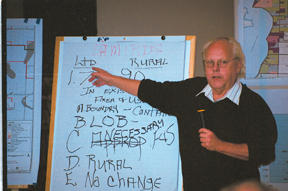|
GMA: Development: Lopez Village looks for options Dec. 6, 2002
Lopez Island, WA - It would be difficult to find someone who knows more than Bill Nielsen about the state’s Growth Management Act and San Juan County’s attempts to comply with it. So, when the former head of the Western Washington Growth Management Hearings Board visited Lopez Island on Nov. 25 to explain options county officials have for accommodating growth in the village, dozens of islanders dropped by the community center to hear the details. The Mount Vernon resident, who retired Sept. 1 after two terms as the hearings board’s presiding officer, authored most if not all of the legal opinions regarding the county’s Comprehensive Plan, including the May 7, 2000, decision warning about “sticker shock” that would follow plans to make Eastsound and Lopez Village ready for urban growth. The board found the county had not complied with state planning guidelines because it had not accounted for the costs of developing services like water and sewer for a densely populated area. “A local government may not adopt an expansive (Urban Growth Area) without recognizing and providing for the expansive costs of infrastructure,” the hearings board stated in its decision. Nearly two years after that ruling, the problem of providing services has not gone away and costs remain one of several priorities county officials must balance in planning for growth. Michelle Smith, a member of a local committee exploring the rural village option, doubts enough water is available to support a village with half as many residents in 2020 as Friday Harbor now has. “I think what Mr. Nielsen’s explanation points out is that the county once again got the cart before the horse,” Smith said of the need to address water and sewer limitations before designating the village as a urban growth area. “Their planning for Lopez Village has been backwards from the beginning.” Nielsen said reducing sprawl, allowing for growth, providing for affordable housing and protecting the island’s rural character are competing concerns the Comp Plan needs to accommodate. Current plans call for about 600 new homes on Lopez Island — half in the village — to accommodate future growth. If the Urban Growth Area is scrapped, county planners must devise another plan and new options for projected growth. “The (GMA) is kind of like a balloon,” Nielsen said of the balancing act of the GMA. “If you push on one side too far, it pops out on the other. The county has responsibility to solve the problem and they have lots of options, but one of them is not walking away.” Nielsen said the village becomes a rural residential neighborhood with no expansion of services if county officials decide on a “do-nothing” approach. Few services and little development will follow if they choose to designate the area a “rural village,” an option that protects against growth. Designating the village a Limited Area of More Intense Rural Development (LAMIRD) limits development to services that were “on the ground” as of June 1, 1991, the date the GMA was adopted. Though an Urban Growth Area would solve county plans for accommodating growth and providing for affordable housing, Nielsen said such a designation requires firm plans be in place for water, sewer, transportation and drainage of stormwater runoff. But, he added zoning restrictions can limit what type and where development can occur so that urban growth in Lopez Village does not eventually look like Seattle or Friday Harbor. “The only designation that allows flexibility for growth is the UGA,”
he said. “But solving the infrastructure problem is critical, and
if sewer and water lines cannot be upgraded it becomes rural and that’s
the end of the question.” |
 grow
without water and sewer service. Doris Aitken of the Fisherman Bay
Sewer District said her agency may be able to accommodate future growth.
grow
without water and sewer service. Doris Aitken of the Fisherman Bay
Sewer District said her agency may be able to accommodate future growth.